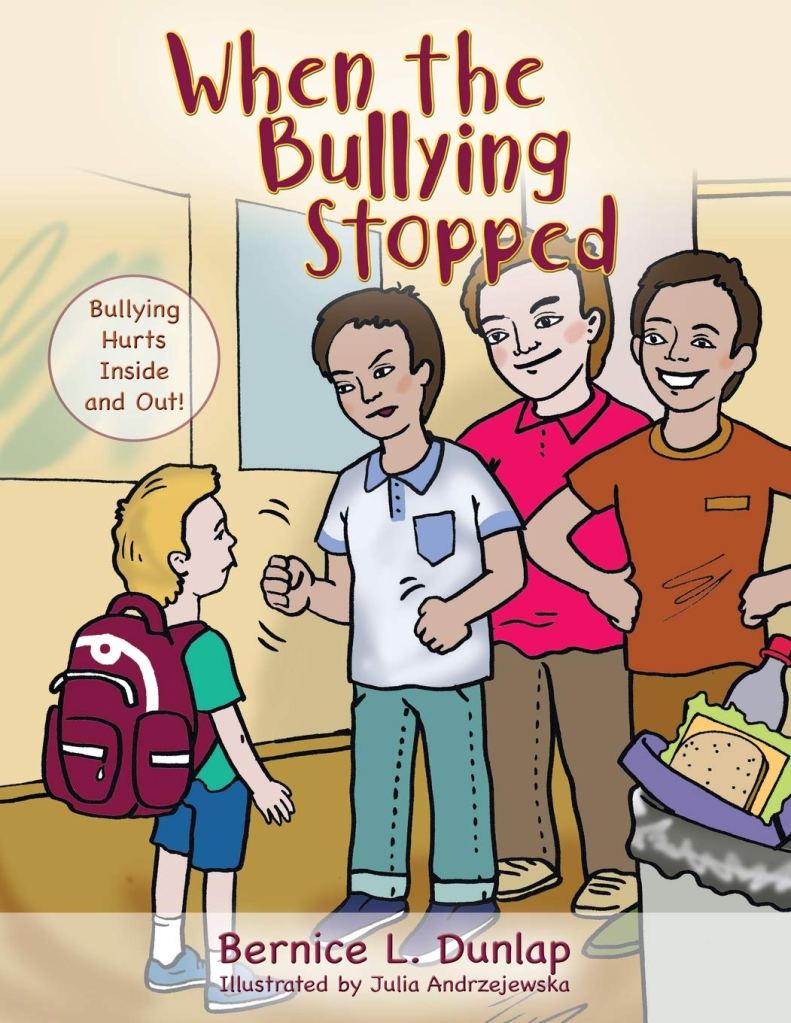
And … on to the review!

OFFICIAL DESCRIPTION*:
KEEPING SILENT ABOUT BULLYING ENABLES IT TO CONTINUE
This story is about an eight-year-old boy named Peter, who was in the third grade at Leonard Street Elementary School. Alex and his friends, Max and Jax, picked on Peter every day. These boys were also in the third grade at the same school. This bullying made life miserable for Peter, and he knew he had to find the courage to tell his parents how Alex and his friends were terrorizing him at school.
REVIEW:
Oh, how the world needs more books like this one.
In When the Bullying Stopped, written by Bernice L. Dunlap and nicely illustrated by Julia Andrzejewska, we start with three bullies and one victim: Peter. Peter is a bit less muscled and a whole lot less of a dominant personality than Alex, the bullies’ ringleader, as well as Max and Jax, Alex’s sidekicks. (I am curious why the author chose to end all three bullies’ names in ‘X’s! I found it interesting––but that may just be coincidental.) Alex and co. give poor Peter a rather rough time, trashing his lunch one day and stealing his lunch money the next. Peter is a good boy, although he feels mighty small when faced by those bullies, so while he is at first afraid enough to go hungry, he eventually brings his parents and the school principal into the conversation, and just desserts (suspensions) are handed out to the three villains. Two of these villains, Jax and Max, move out of town (and therefore the narrative) at this point, while Alex continues on.
The book then transitions to following Alex instead of Peter, and here is where the bully becomes the bullied. Some kids from another local school rough Alex up, and he is left injured and frightened by the experience. Peter, who is indeed a very good boy, attempts to help his former bully despite Alex’s protests and the other kids in the schoolyard keeping well enough away. (I assume this is because they themselves had been hurt by Alex and co. in the past, and were hesitant to get near him––but this might prove an interesting point for discussion.) Peter then searches out the principal on his own and finds Alex the help he needs. Receiving assistance from someone he has wronged in the past proves a good learning experience for Alex, who eventually changes his ways and makes friends with Peter, gaining the confidence of his other peers as well.
All of this, and in only 24 pages!
The book pages are divided evenly between alternating full-page illustrations and full-page text-centered pages. There is quite a lot of text on those latter pages, proportionate to the page number, so I do recommend that readers take it slow and spend ample time pointing out what they see mirrored in the illustrations. The text is nicely edited and formatted for When the Bullying Stops to be an easy read for those who, like me in my library life, have to read their picture books upside down. I appreciate a readable-while-inverted book!
While I did not notice any negatives while reading, I do have two suggestions in order to ensure that those using this book meet with the best possible success. Parents, grandparents, teachers, and other caregivers will want to make sure to define and contextualize some of the more advanced words or terms used by Dunlap; a word like “protruding” or a term like “fetal position” are entirely possible to explain, especially in context, but they are unlikely to prove easily understandable to younger readers in kindergarten or, possibly, first grade. My other suggestion for these same youngest readers would be to break up the reading of the book into two distinct readings with some discussion in between as well as after. While the story itself is straightforward, the first section deals with a victim of bullying making the great decision to report his experiences to his parents and principal, and the second section deals with the bully, who after he is suspended is bullied himself. The book ends with some possibilities for rich future discussion with young readers. Why did the other children, many of whom had been bullied themselves, not assist the bully when he was beaten up? What does this book tell us about forgiveness and compassion? How would you respond if someone threw your lunch in the trash? … and so on.
I’m excited to see what all this book can do out there in the world, in homes and classrooms. And speaking of classrooms, I’m very interested indeed to see how this next year of hybrid/remote/classroom education settles out. Here’s hoping we achieve a new (and healthy, happy) normal sometime soon!
As a final note, consider this book’s title: When the Bullying Stops. What does happen afterward? As Dunlap suggests, it may just be an opening for personal growth, change, and classroom rapport. I’m sure you all might have some suggestions, as well!
IN SUMMARY:
In a world where bullying is tragically common, an accessible picture book like When the Bullying Stopped by Bernice L. Dunlap might just make a big difference in a child’s life. I also highly recommend checking out Dunlap’s other books for children.
WHERE TO BUY?
You can find Stella the Rejected Star wherever good books are sold, including Bookshop.org, Barnes & Noble and Amazon. You can also find out more about Marc McCormack’s work on the book’s Outskirts Press author page.
WHAT NEXT?
I received a copy of this book in exchange for an honest review.
* Courtesy of Outskirts Press book listing.

